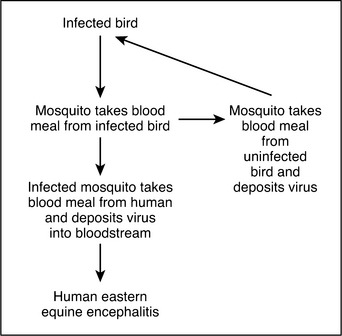EASTERN EQUINE ENCEPHALITIS
TRANSMISSION
EEEV is seen primarily east of the Mississippi River. The natural hosts for EEEV are passerine birds, such as blackbirds, finches, jays, sparrows, and warblers. The virus is found mainly in or near swampy areas or wetlands and is transmitted through the bite of an infected mosquito. Horses and humans are infected when a mosquito takes blood from an infected bird and subsequently takes blood from a horse or human and deposits the virus at the site of the bite. Horses and humans do not develop a significant enough viremia, or virus level in the blood, to be a source of infection to other animals via a mosquito bite; they are, therefore, considered dead-end hosts (Figure 14).
EASTERN EQUINE ENCEPHALITIS IN HORSES
EEEV in horses causes a central nervous system (CNS) disease. An infected horse either dies suddenly or shows progressive signs of CNS deterioration, with death 2 to 3 days after the onset of clinical signs. Mortality can reach 75% to 90% in infected animals. Mildly infected horses may recover over a 2-week period but are left with some degree of permanent brain damage. All equines (e.g., mules and donkeys) are susceptible to EEEV infection. Birds such as ostriches, emus, quails, turkeys, and pheasants are also susceptible to EEEV infection.
Stay updated, free articles. Join our Telegram channel

Full access? Get Clinical Tree



